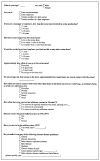Serologic evidence of H1 swine Influenza virus infection in swine farm residents and employees
- PMID: 12141967
- PMCID: PMC2732505
- DOI: 10.3201/eid0808.010474
Serologic evidence of H1 swine Influenza virus infection in swine farm residents and employees
Abstract
We evaluated seropositivity to swine and human H1 influenza viruses in 74 swine farm owners, employees, their family members, and veterinarians in rural south-central Wisconsin, compared with 114 urban Milwaukee, Wisconsin, residents. The number of swine farm participants with positive serum hemagglutination-inhibition (HI) antibody titers > or = 40 to swine influenza viruses (17/74) was significantly higher (p<0.001) than the number of seropositive urban control samples (1/114). The geometric mean serum HI antibody titers to swine influenza viruses were also significantly higher (p<0.001) among the farm participants. Swine virus seropositivity was significantly (p<0.05) associated with being a farm owner or a farm family member, living on a farm, or entering the swine barn > or = 4 days/week. Because pigs can play a role in generating genetically novel influenza viruses, swine farmers may represent an important sentinel population to evaluate the emergence of new pandemic influenza viruses.
Figures
References
-
- Murphy BR, Webster RG. Orthomyxoviruses. In: Fields BN, Knipe DM, Howley PM, Chanock RM, Melnick JL, Monath TP, et al., editors. Fields virology. 3rd ed. Philadelphia: Lippincott-Raven Publishers; 1996. p. 1397–445.
-
- Bridges CB, Fukuda K, Cox NJ, Singleton JA. Advisory committee on immunization practices: Prevention and control of influenza. Recommendations of the Advisory Committee on Immunization Practices (ACIP). MMWR Morb Mortal Wkly Rep. 2001;50:1–44. - PubMed
-
- Easterday BC, Hinshaw VS. Swine influenza. In: Leman AD, Straw BE, Mengeling WL, D’Allaire S, Taylor DJ, editors. Diseases of swine. 7th ed. Ames: Iowa State Press; 1992. p. 349–57.
-
- Olsen CW. The emergence of novel swine influenza viruses in North America. Virus Res. 2002. In press. - PubMed
Publication types
MeSH terms
Substances
LinkOut - more resources
Full Text Sources
Medical

